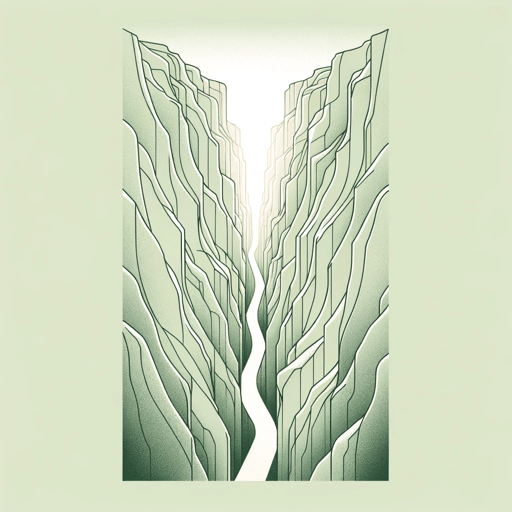55 pages • 1 hour read
Dusti BowlingThe Canyon's Edge
Fiction | Novel/Book in Verse | Middle Grade | Published in 2020A modern alternative to SparkNotes and CliffsNotes, SuperSummary offers high-quality Study Guides with detailed chapter summaries and analysis of major themes, characters, and more.
Summary and Study Guide
Overview
Trapped in a slot canyon after a flash flood, Nora braves myriad desert dangers—and her personal demons—as she fights to save her father in Dusti Bowling’s middle-grade survival novel in verse, The Canyon’s Edge (2020). Snakes, scorpions, and dehydration aren’t the only dangerous obstacles Nora must overcome. To survive, she must master post-traumatic stress disorder (PTSD) and begin to cope with the loss of her mother, the victim of a mass shooting that the whole family experienced. Bowling sensitively explores the themes of Healing From Trauma, The Keys to Survival, and Finding the Courage to Live. The novel received starred reviews from Kirkus, School Library Journal, Booklist, and Publisher’s Weekly and was nominated for several state reading awards.
In the novel’s acknowledgements, the author shares that The Canyon’s Edge is based on a tragic, real-life experience. Bowling and her family hiked a slot canyon in Payson, Arizona, in early July 2017. Days later (on July 15), a large extended family from Bowling’s hometown hiked the canyon but was trapped in a flash flood. The author notes that nine family members perished; other media accounts report that 10 people lost their lives. While Bowling didn’t personally know the family, she confides, “I’ve never been able to stop thinking about them,” and adds that she wrote the novel “partly as an expression of [her] grief for that family, but also for everyone who has suffered great losses in the blink of an eye” (303).
This guide refers to the Little, Brown and Company edition (2020).
Content Warning: The Canyon’s Edge references the death of a loved one and gun violence.
Plot Summary
On Nora’s birthday, the one-year anniversary of the shooting that killed her mother, Nora and her father rise early to explore a remote slot canyon in the desert. Nora’s parents, both enthusiastic outdoor adventurers, passed their love and knowledge of the desert on to Nora. Climbing down and exploring the canyon will be Nora and Dad’s first outdoor trip since the tragedy. Nora hopes it will help them return to normal.
Both Nora and Dad have PTSD and unprocessed emotions from the shooting. Nora has built an emotional wall out of her feelings of guilt, shame, and anger to protect herself from the Beast, a figure that torments her nightmares. She even pushed away her best friend, Danielle, after the shooting—but misses their friendship. Nora attends sessions with a therapist named Mary to help deal with PTSD and her loss. Dad, who was hit and injured in the same shooting that killed Mom, is now fearful of people and public places.
Upon arriving at the edge of the narrow slot canyon, the two rappel down into it and hike along its bottom. Nora composes a poem about the beautiful canyon walls. Mom was a writer, and writing poetry makes Nora feel closer to her. At the restaurant where Nora chose to celebrate her birthday, Mom was killed when a gunman entered and started shooting. Before she died, Mom pushed Nora to safety under a table and told her she loved her. Another diner, a mother named Sofía Moreno, tackled the gunman. She died, but her actions saved everyone else. Nora feels guilty for surviving. Searching for a reason behind her tragedy, she struggles to understand why someone would do something so horrible.
In the canyon, Nora and Dad argue because he refuses to let her return to school. They hear a sudden noise, feel a tremor, and then see a wall of water rushing toward them. He pushes Nora up the canyon wall above an outcropping before the water sweeps him away.
Nora hangs on until the water recedes and then slides down to the ledge. It’s too muddy after the flood to search for Dad. She waits for him to find her, spending a freezing night dreaming of the shooting and the Beast. She refuses to heed Mary’s advice to empower herself and “rewrite” her nightmare.
In the morning, Nora searches for Dad. She drinks water from rapidly receding puddles, avoids a rattlesnake, and finds mesquite beans to eat. She thinks Dad must be working his way back toward her. An evening thunderstorm threatens, and Nora fears another flood. In a panic, she free-soloes 20 feet up the canyon wall to a cave. There, she gives in to her rage, hacking off her long “Before”-the-shooting hair and leaving only a stubble of darker “After” hair. Nora feels like her life is divided into these two periods. She rebuilds her mental wall, hoping for emotional numbness.
A venomous scorpion stings her, and she falls into a waking dream. She hears the Beast coming for her and then feels Mom’s presence, protecting her. Nora dreams of Mom’s funeral and various Beatles songs that Mom loved. Mom’s song for Nora was “Blackbird” because she wanted Nora to find her strength. Nora survives the night and realizes that she needs to save Dad instead of expecting him to rescue her. She triumphantly climbs the rest of the way out of the canyon.
Throughout Nora’s ordeal in the desert, the advice of her therapist, Mary, echoes in her head. The desert is fiercely hot, and Nora is dehydrated, sunburned, fatigued, weak, and injured, but she refuses to give up. She searches the canyon below for Dad. Nora finds him, unconscious and injured, on a ledge just below the lip of the canyon—but on its other side. Nora realizes she wants to live and do more with her life. She decides to jump the canyon to reach Dad. Nora releases her self-doubt and negative emotions, rewrites her nightmare, defeats the Beast, lets her wall crumble, and focuses on Mom, Dad, and Danielle’s love for her. Nora feels Mom with her as she jumps. Dad is alive. Overcoming her experience of trauma and fear of guns, Nora uses Dad’s flare gun to set a dry tree on fire, drawing the attention of a helicopter, which rescues her and Dad.
Much later, Nora reads her poetic account of her trials to Dad, leaving him in tears. Nora now looks forward to moving on with her life, the “After After.” She visits Danielle, who warmly welcomes her friend.
Related Titles
By Dusti Bowling
Featured Collections
Action & Adventure
View Collection
Animals in Literature
View Collection
Family
View Collection
Fear
View Collection
Fiction with Strong Female Protagonists
View Collection
Good & Evil
View Collection
Grief
View Collection
Guilt
View Collection
Mental Illness
View Collection
Realistic Fiction (High School)
View Collection
Realistic Fiction (Middle Grade)
View Collection
Safety & Danger
View Collection
School Book List Titles
View Collection
Science & Nature
View Collection
Sexual Harassment & Violence
View Collection
The Journey
View Collection



